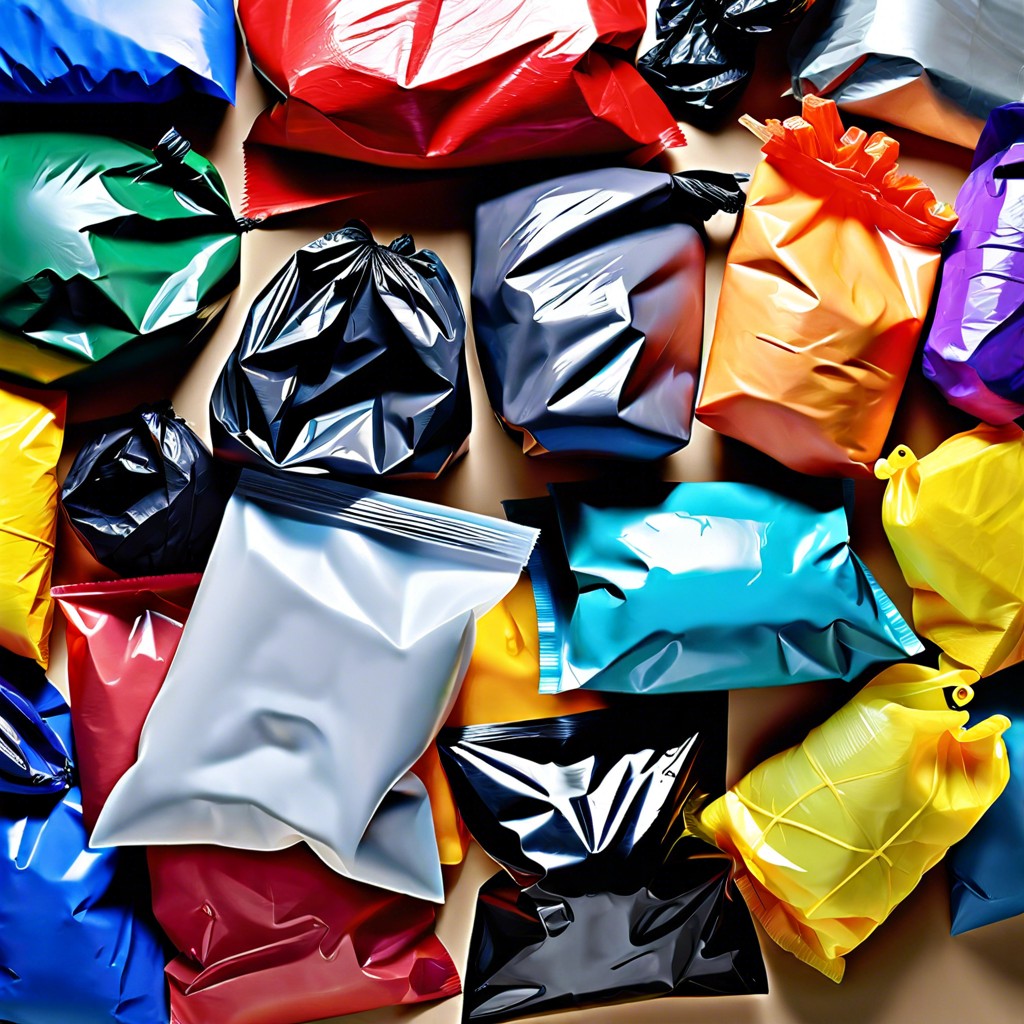Last updated on
Discover the various garbage bag sizes in gallons to determine the perfect fit for your trash needs.
Navigating the confusing land of garbage bag sizes can feel like a quest for the Holy Grail—who knew trash had so many options? Whether you’re trying to conquer kitchen chaos, tame bathroom bins, or tackle construction debris, we’ve got you covered. Dive in and discover the perfect fit for every trash can, nifty features like drawstrings, and even eco-friendly choices that’ll make Mother Earth smile. Let’s put the “fun” back in “fundamentally necessary home chores”! Time to take out the guesswork from taking out the trash.
Key takeaways:
- Various sizes range from 4 to 60 gallons.
- Kitchen bags typically hold 13 gallons of waste.
- Outdoor bags are larger for heavy debris management.
- Specialty bags support yard and construction needs effectively.
- Eco-friendly options include compostable and biodegradable materials.
What's Inside
Understanding Common Trash Bag Sizes

Trash bag sizes are typically measured in gallons, which helps in choosing the right fit for your trash cans and waste needs.
Small bags, around 4-6 gallons, are perfect for bathrooms and bedrooms. Medium bags, typically 8-12 gallons, fit most kitchen bins and are versatile enough for various household uses.
For heavy-duty jobs or more considerable waste, like yard work or garage cleanouts, large bags of 20-30 gallons are ideal. Then you have the gigantic ones, 40 gallons or more, often seen in offices or outdoor event spaces.
Knowing these basic sizes can save you from those awkward moments when you have a bag that’s either too tiny or ridiculously oversized for your trash can. Trust me, trying to stuff a watermelon rind into a 4-gallon bag is the epitome of frustration.
Kitchen Trash Bag Sizes
For your kitchen, you’re often dealing with the typical 13-gallon trash bags. These fit the standard kitchen trash can and are perfect for everyday waste like food scraps, packaging, and the occasional questionable science experiment from the back of the fridge.
If you find yourself hosting a big dinner and generating more waste than usual, consider upsizing to a 20-gallon bag. It’s like giving your trash can stretchy pants for Thanksgiving dinner.
For smaller kitchens or those trying to stick to composting and recycling, you might opt for 8-10 gallon bags. They’re perfect for a compact bin and can help you take out the trash more frequently to avoid any stinky situations.
Keep a few extra bags stashed under the sink; you’ll thank me on a rainy Tuesday when the coffee grounds get out of control.
Bathroom and Bedroom Trash Bag Sizes
When it comes to trash bags for the bathroom and bedroom, you often don’t need anything bigger than 4 to 10 gallons. These smaller bags fit discreetly into smaller trash cans, making them a perfect match for spaces where waste doesn’t pile up as fast.
- Here’s why that size works:
- Less clutter: No one wants a giant trash bag taking up half the bathroom.
- Odor control: Smaller bags mean you’re taking the trash out more often, which keeps the smells at bay.
- Easy to replace: Just yank it out, tie it up, and toss it in the main bin. Simple.
Got a home office? Bedroom areas can use the same size. Fewer snack wrappers or tissues lying around, and you’ve got yourself a tidy space. Plus, it’s not a workout to lift a 10-gallon bag of used tissues!
Consider the 4- to 10-gallon range the Goldilocks zone for these areas—just right.
Outdoor Trash Bag Sizes
When it comes to tackling those yard chores, having the right size trash bag is a game changer. Outdoor debris can vary greatly, so your trash bags need to handle everything from leaves to broken branches and old garden gnomes (yes, those creepy ones).
First, let’s talk leaves. For those autumn clean-ups, 30 to 39-gallon bags are your best buddy. They’re big enough to hold a decent pile without exploding like a popcorn kernel under heat.
For larger debris like broken branches or garden parties gone wrong, you’ll want something hefty. Look for bags in the 40 to 55-gallon range. These bags have the toughness and the volume to hold everything, including that one soggy lawn chair you’ve been avoiding.
Then there are the massive 60-gallon and above bags. These are the superheroes of the trash bag world, swooping in to save you from unwieldy, heavy-duty yard waste like logs, rocks, or the remains of a DIY garden project that didn’t quite go as planned.
Oh, and a little pro tip: opt for bags with extra thickness or heavy-duty labels. Let’s face it, no one wants to deal with a bursting bag of wet grass.
For those of you with dreams of perfect lawns, there are specific grass clippings bags, usually around the 33-gallon range. Breathable to keep things from turning into a bog, they ensure that your grass stays where it belongs – in the bag and not all over your shoes.
Happy yard cleaning!
Specialty Trash Bag Sizes for Yard Waste
When it comes to yard waste, standard garbage bags just won’t cut it. You’ll want something tough, roomy, and capable of holding all those grass clippings, leaves, and garden trimmings. The usual sizes you’ll find for yard waste bags range from 30 to 55 gallons. They’re designed to handle bulky, irregularly shaped debris without tearing.
Look for bags labeled as “contractor bags” or “yard waste bags.” These typically offer extra durability. Bags made from heavy-duty plastic or biodegradable materials are ideal. Nobody wants a trail of leaves leading to their front door.
Remember, yard waste bags are green for a reason—the color! It helps them blend with your garden and is a little visual treat for your neighbors. And hey, who doesn’t appreciate a nicely camouflaged pile of refuse?
For those with extensive landscaping projects, consider those mega 55-gallon behemoths. They’ll save you from multiple trips to the curb, and bonus, you get a good arm workout lugging them around!
Specialty Trash Bag Sizes for Construction Debris
When it comes to construction debris, not just any trash bag will do. You need something heavy-duty and up for the job. Think of these as the bodybuilders of the garbage bag world.
Firstly, these bags come in sizes like 42 gallons or even larger. They are perfect for hauling around chunks of drywall, wood, or that ill-fated DIY project that didn’t quite pan out.
Secondly, the material matters. Look for contractor bags made from 3 mil thick plastic. They can handle sharp objects without tearing, unlike that puny kitchen bag.
Finally, some brands come with nifty extras like reinforced bottoms. Because the last thing you want is your bag wimping out halfway to the dumpster.
For weight, these bags often support up to 50 or even 60 pounds. Imagine a strong friend who doesn’t complain about carrying your stuff.
If you’re tackling a big remodel, you can’t go wrong with these spacious and robust options. They’ll make the cleanup almost as satisfying as the renovation itself.
Matching Bag Sizes to Trash Can Dimensions
Finding the right trash bag for your waste bin is like Cinderella finding her glass slipper. It’s got to be just right!
First, measure your trash can. You need the height, width, and depth. This helps avoid the dreaded too-small-bag fiasco.
Next, match the bag’s gallons to your bin’s volume. A 13-gallon can usually needs a 13-gallon bag, though a little wiggle room never hurts.
Opt for a little extra length if you’re not a fan of the bag slipping into the can during a garbage overload. Trust me, nobody enjoys fishing out a bag with yesterday’s spaghetti.
Consider the shape of your bin. Rectangular bins might need a different fit compared to round ones. Yes, bags can be picky.
Lastly, notice any added features on your bag: drawstrings or flap ties can make a difference in fit and ease of use.
Remember, picking the right size saves you from bag woes and maybe even a few awkward cleanups.
Conversion Guide for Volume and Capacity
Let’s get ready to convert like kitchen wizards. Picture your trash can as a cauldron needing the perfect potion!
1 gallon = 231 cubic inches. You might not care about those specific inches, but think of a small carton of ice cream. That’s roughly a gallon.
For larger bags:
- 10 gallons = 2 kitchen-sized bags full of potato chips.
- 30 gallons = One of those massive cereal boxes… times five.
- 50 gallons = Your beach cooler on a party day.
If your trash can is 20x15x8 inches, multiply those dimensions together (20x15x8 = 2400 cubic inches). Divide that number by 231, and boom, you’ve got a little over 10 gallons.
Remember the mantra of conversion: measure, multiply, divide, and conquer!
Special Features of Trash Bags (e.g., Drawstrings, Odor Control)
Trash bags have evolved beyond just being a plain plastic sack. These features can make a significant difference in your daily trash duties:
Drawstrings: No one enjoys the surprise of a garbage bag imploding right before it gets to the bin. Drawstrings make tying up and carrying the trash a breeze. Plus, they save your hands from doing that awkward “hug-the-garbage” maneuver.
Odor Control: Admit it, some days the trash can smells like a biology experiment gone wrong. Bags with built-in odor control—thanks to activated charcoal or scented liners—help keep those weird smells in check.
Heavy-Duty Strength: For those of us who treat the trash can like it’s competing in the world’s strongest man competition, bags with reinforced strength are a lifesaver. Ideal for heavy or sharp-edged waste.
Stretch Technology: Bags with flex or stretch technology accommodate more garbage and resist tears. Think of them as the yoga pants of the trash bag world—flexible and forgiving.
Eco-Friendly Materials: Feeling a pang of eco-guilt? Options made from recycled or biodegradable materials help you take out the trash without tossing your green values out the window.
Labeling and Color Coding: Separate recycling, compost, and landfill waste easily by using bags with specific labels or colors. No more “oops” moments when you realize that pizza box wasn’t actually compostable.
Remember, these features aren’t just luxuries; they can transform a mundane chore into something almost—almost—a tad enjoyable.
Eco-Friendly Trash Bag Options
Eco-friendly trash bags are a fantastic way to help reduce your carbon footprint. One popular option is compostable bags. These are made from plant-based materials like cornstarch and are designed to break down in a composting environment. Perfect for those who compost in their backyards or participate in a municipal composting program.
Another option is biodegradable bags. These decompose when exposed to natural elements like sunlight and air. However, they might not break down completely in a landfill environment due to lack of exposure.
Recycled plastic bags are a third choice. They use post-consumer or post-industrial recycled plastic, giving old materials a second life. It’s a great way to support recycling industries and cut down on new plastic production.
Look for certifications like the BPI (Biodegradable Products Institute) or ASTM D6400 to ensure the bags meet eco-friendly standards. And remember, while these bags are better for the environment, reducing waste wherever possible is still the gold standard.




